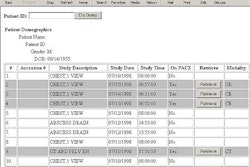BOSTON - The cost justification of PACS focuses primarily on "hard" savings gleaned through reducing or eliminating hardcopy images, processors, and chemistry, as well as film transport and storage. "Soft" savings justifications, on the other hand, focus on increased throughput, improved patient care, and referring clinician satisfaction with these systems. Meanwhile, eliminating the use of paper entirely can confer additional efficiencies on a radiology department’s workflow, according to researchers from Maine Medical Center (MMC) in Portland, ME.
"The potential gains from going paperless can be maximized by appropriate planning and implementation," said Dr. Matthew Ralston, a radiologist at MMC. Ralston presented his department’s experience with reducing the flow of paper to an audience at the Symposium for Computer Applications in Radiology on Sunday.
Most of the 175,000 annual exams at MMC are conducted at locations remote from the reading radiologists. This allows radiologists to interpret images without being tethered to paperwork or the location where the study originated, Ralston said.
Prior to the introduction of PACS at the institution, several pieces of paper were stored in the radiology film jacket. With the transition to a filmless environment, this storage option was no longer available. Ralston and his team, using an iterative process, created lists of the types of paper forms that were generated in the pre-PACS environment, and identified which forms could be replaced electronically.
The researchers looked at where the forms came from, what purposed they served, and where each form finally came to rest. These were found to be areas as disparate as the film folder, medical records management, or even the trashcan, Ralston said.
The group identified five workgroup areas where paperwork could be reduced, or in some cases, eliminated entirely. These workgroups were the film library, the radiologists, the transcription department, the technologists, and the referring clinicians.
Paperwork for the film library was almost completely eliminated, according to Ralston. As a PACS, by definition, means that there are no more film jackets, this paper form was abolished.
"There is one remaining glitch, which is the patient consent forms for contrast administration and invasive procedures. We are still utilizing paper consent forms, which are stored manually," he noted.
For the radiologists, the group has managed to create a system whereby any exam performed in the system can be interpreted from any workstation without the need for a paper requisition form or a printed schedule.
"This has been achieved through tight integration of the PACS with our RIS and with the transcription system. This has created a benefit in increased productivity, a balanced workload, and a decreased stress level for our radiologists," Ralston said.
The team also created an application interface that replaced the paper-based peer-review process used in the institution’s pre-PACS era. The new process uses PACS keywords and comments fields and is preferred over the previous procedure, noted Ralston.
The facility uses transcriptionists instead of a voice-recognition system, and has trimmed report turnaround time to two hours, primarily due to the abandonment of a hard-copy transcription request form. This form, Ralston said, was frequently prone to snags, such as being lost or misplaced.
The PACS network has been integrated with a digital dictation system that automatically routes an order number to the transcription department on completion of a radiologist’s read. This ensures that the voice file is immediately available to the transcriptionists and can be worked on without waiting for paperwork.
Ralston and his team at MMC were able to substantially reduce paperwork for their facility’s technologists as well. By integrating the RIS and PACS through the DICOM modality worklist functionality and the Modality Performed Procedure Step (MPPS), technologists no longer have to enter patient demographics manually. In addition, they have created a tool that allows a technologist to compare the daily study log with the studies that arrived successfully at the server to assure that all cases performed that day were archived.
"There is still a printed requisition form as a placeholder and a note pad for writing protocols and handling messages between technologists with one another and with the radiologists. But the paperwork is discarded as soon as the relevant exam is completed, and all the tracking of the exams is performed via the RIS," he said.
The referring clinicians have seen the greatest boon to the paperwork reduction brought on by the use of the PACS with the RIS. Inpatient and outpatient reports, with images, are now commonly available on the department’s Web server within two hours of an exam’s completion, Ralston said. In addition, the reports are routed to the HIS for the inpatients and are then available on the hospital’s electronic medical record.
Ralston advised that institutions that are adopting PACS specify and build their system to allow for a paperless transition. He also cautioned the SCAR audience that they should focus on one subset of paperwork to eliminate at a time. This ensures that the transition to electronic orders is systematic and not a chaotic mix of paper forms combined with electronic transactions.
He also advocated the use of a RIS to achieve maximum benefit from a PACS implementation.
"A good PACS is necessary but not sufficient, by itself, for a paperless transition. So much of our success depends on what we also can do in the RIS," he said.
By Jonathan S. Batchelor
AuntMinnie.com staff writer
June 9, 2003
Copyright © 2003 AuntMinnie.com


















